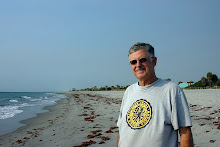There seems to be enough evidence present to consider that the Fort
Lauderdale Sunrise Shipwreck to be of British origin. Some of the artifacts point in that direction. As far as it is known at this time none of the artifacts point to any other origin.
These artifacts, and others, were recovered in 1956/57 from the primary cultural deposit located about 1/2 mile off shore from the beach at Fort
Lauderdale, Florida.

First, there is the sextant with the maker's name and city, "W.
Hogg, London".

Then there is the silver or pewter spoon with the name of the maker and city, "P. Barnes & Co., London"


Next, is the pottery shard with a maker's mark, identified as used by John Davenport, Great Britain, 1793 - 1882.
Also, there is this partial saucer or plate of edged
pearlware, refined
eathernware, England, 1785 - 184o. Note the small piece in the upper right that may have come from another edged
pearlware saucer or plate because the edged pattern is curved slightly, in contrast to that of the larger ceramic.


Finally, there are the coins. Of the 40 or so legible Spanish coins recovered, only one was minted in the New World, from the Mexico mint. Note the mint mark on the reverse at about 8 o'clock on this 1788 coin. The rest of the legible coins were minted in Spain.
When we recovered
Spanish coins we thought that they must have come from a Spanish ship. It was only a year or two ago that I learned that such an assumption was incorrect. Actually, Spanish coins were the primary medium of exchange in the American colonies, and continued to be so until just before the the American Civil War. There were a number Spanish Mints in the Americas. So if the ship was a trader plying the waters of the American Atlantic and Gulf coasts, it seems that there should be a large percentage of Spanish coins found with New World mint marks. But, in this case only one of about 40 legible Spanish coins is New World minted.
Of course these artifacts do not prove British origin. It's only that there is likely a connection.





